Physical Address
304 North Cardinal St.
Dorchester Center, MA 02124
Ultrasonography (USG) has many advantages for imaging the airway: It is safe, quick, repeatable, portable, widely available, and gives real-time dynamic images.
The cricothyroid membrane (CTM) can easily be identified by USG prior to management of a difficult airway, and this technique should be applied if there is uncertainty about the ability to identify it with inspection or palpation methods.
USG must be used dynamically for maximum benefit and in direct conjunction with airway management (immediately before, during, and after airway interventions).
Direct observation can be made of whether an endotracheal tube (ETT) is entering the trachea or the esophagus by placing the ultrasound probe transversely on the neck at the level of the suprasternal notch during intubation; in this way, intubation can be confirmed without the need for ventilation or circulation. Ventilation can be confirmed by observing the lung sliding bilaterally.
USG should be the first-choice diagnostic approach when a pneumothorax is suspected intraoperatively or during initial trauma evaluation.
Prandial status can be estimated by determining if the stomach is empty or if it contains fluid or solids and quantifying the amount of gastric fluid.
Percutaneous dilatational tracheostomy (PDT) can be improved by using USG for identifying the correct tracheal-ring interspace, avoiding blood vessels, and determining the depth from the skin to the tracheal wall.
Numerous conditions that affect airway management can be diagnosed by preanesthetic USG, but it remains to be determined in which patients the predictive value of such an examination is high enough to recommend USG as a routine approach to airway management planning.
Ultrasonography (USG) is becoming an established tool in the hands of physicians for the acute and elective care of patients’ airways, and its use can now be considered fundamental in management of the difficult airway (DA). , USG has many potential advantages: It is safe, quick, repeatable, portable, widely available, and gives real-time dynamic images. USG must be used dynamically in direct conjunction with airway procedures for maximum benefit in airway management. For example, if the transducer is placed on the neck, the endotracheal tube (ETT) can be visualized passing into the trachea or the esophagus while it is being placed, whereas the location of the ETT is difficult to visualize if the transducer is placed on the neck of a patient who already has an ETT in place.
Ultrasound refers to sound frequencies beyond 20,000 Hz; frequencies from 2 to 15 MHz are typically used for medical imaging. Ultrasound transducers act as both transmitters and receivers of reflected sound. Tissues exhibit differing acoustic impedance values, and sound reflection occurs at the interfaces between different types of tissues. The impedance difference is greatest at interfaces of soft tissue with bone or air. Some tissues give a strong echo (e.g., fat, bone); these are called hyperechoic structures, and they appear white. Other tissues let the ultrasound beam pass easily (e.g., fluid collections, blood in vessels) and, therefore, create only a weak echo; these are hypoechoic structures and appear black on the screen. When the ultrasound beam reaches the surface of a bone, a strong echo (i.e., a strong white line) appears, and there is a strong absorption of ultrasound, resulting in depiction of only a limited depth of the bony tissue. Nothing is seen beyond the bone because of acoustic shadowing. Cartilaginous structures, such as the thyroid cartilage, the cricoid cartilage, and the tracheal rings, appear homogeneously hypoechoic (black), but the cartilages tend to calcify with age.
Muscles and connective tissue membranes are hypoechoic but have a more heterogeneous, striated appearance than cartilage. Glandular structures, such as the submandibular and thyroid glands, are homogeneous and are mildly to strongly hyperechoic, in comparison with adjacent soft tissues. Air is a very weak conductor of ultrasound, so when the ultrasound beam reaches a border between tissue and air, a strong reflection (strong white line) appears, and everything on the screen beyond that point represents artifacts, particularly reverberation artifacts, which create multiple parallel white lines on the screen. However, the artifacts that arise from the pleura/lung border often reveal useful information. Visualization of structures, such as the posterior pharynx, posterior commissure, and posterior wall of the trachea, is prevented by intraluminal air.
In B-mode (B = brightness) USG, an array of transducers simultaneously scan a plane through the body that can be viewed as a two-dimensional image on the screen, depicting a “slice” of tissue. In M-mode (M = motion) USG, a rapid sequence of B-mode scans representing one single line through the tissue is obtained. The images follow each other in sequence on the screen, enabling the sonographer to see and measure range of motion as the organ boundaries that produce reflections move relative to the probe. In color Doppler USG, velocity information is presented as a color-coded overlay on top of a B-mode image.
The higher the frequency of the ultrasound wave, the higher the resulting image resolution and the less the penetration in depth.
All modern ultrasound transducers used in airway management have a range of frequencies that can be adjusted during scanning to optimize the image. The linear high-frequency transducer ( Fig. 3.1 ) is the most suitable for imaging superficial airway structures (within 2 to 3 cm from the skin). The curved low-frequency transducer is most suitable for obtaining sagittal and parasagittal views of structures in the submandibular and supraglottic regions, mainly because of its wider field of view. The microconvex transducer gives a wide view of the pleura between two ribs. If only one transducer must be chosen, a linear high-frequency transducer enables the performance of most ultrasound examinations that are relevant to airway management. Portable machines can provide accurate answers to basic questions and are sufficient for airway USG.
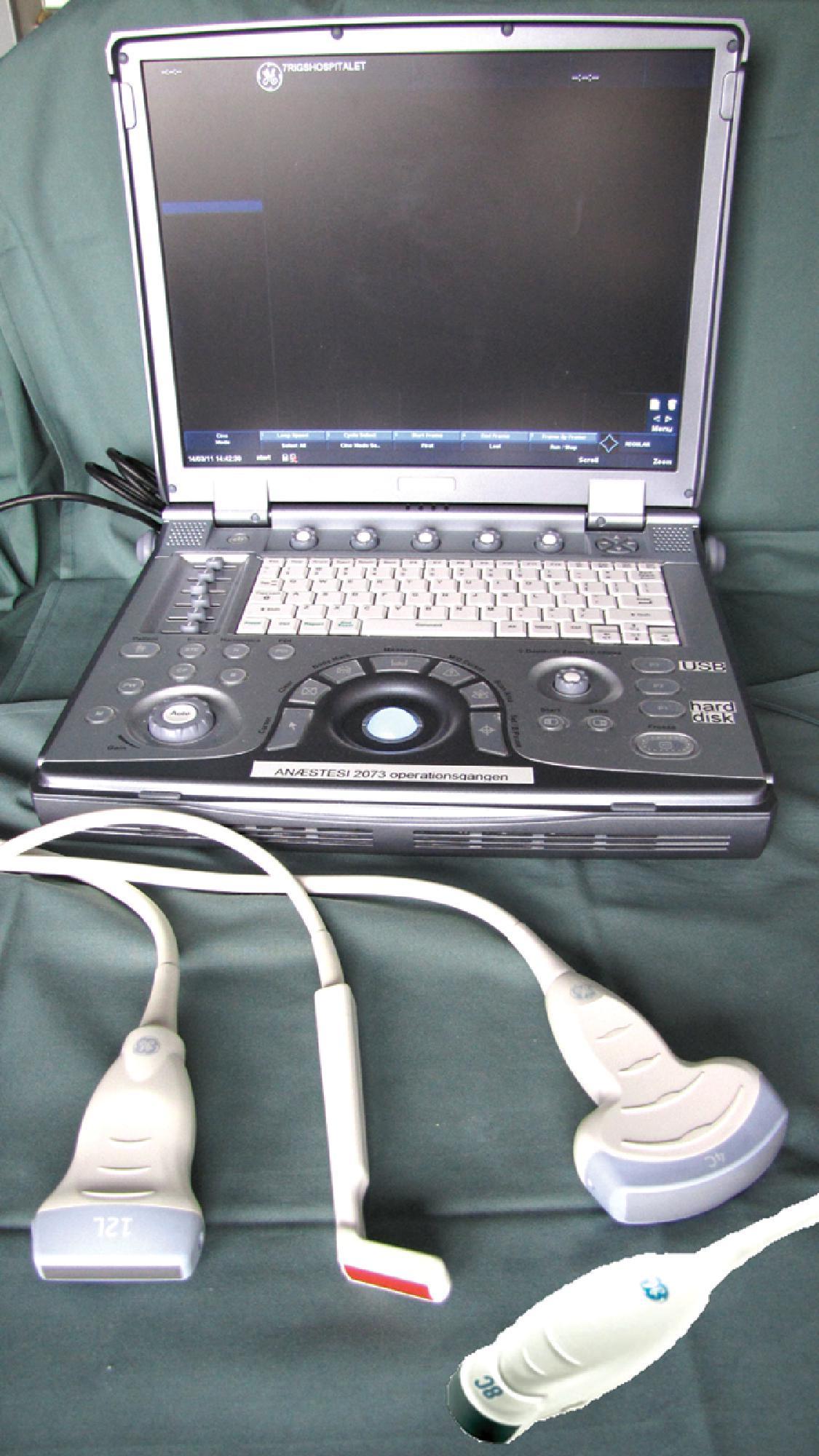
Because air does not conduct ultrasound, the probe must be in full contact with the skin or mucosa without any interfacing air. This is achieved by applying judicious amounts of conductive gel between the probe and the skin. Because of the prominence of the thyroid cartilage, it is sometimes a challenge to avoid air under the probe when performing a sagittal midline scan from the hyoid bone to the suprasternal notch in a male patient.
With conventional transcutaneous USG, the airway can be visualized from the tip of the chin to the midtrachea, along with the pleural aspect of the most peripheral alveoli and the diaphragm. Additional parts of the airway can be seen with special techniques: The trachea can be seen from the esophagus when performing transesophageal USG, and the tissue surrounding the more distal airway from the midtrachea to the bronchi can be visualized with endoscopic USG via a bronchoscope. These special techniques are not covered in detail in this chapter.
USG is a simple method for examination of the mouth and its contents. The tongue is composed of an anterior mobile part situated in the oral cavity and a fixed pharyngeal portion. The lingual musculature is divided into the extrinsic muscles, which have a bony insertion and alter the position of the tongue, and intrinsic muscles, whose fibers alter the shape of the tongue. The tongue can be visualized from within the mouth, but the image may be difficult to interpret. ,
The floor of the mouth and the tongue are easily visualized by placing the transducer submentally. If the transducer is placed in the coronal plane, just posterior to the mentum and from there moved posteriorly until the hyoid bone is reached, one can perform a thorough evaluation of all the layers of the floor of the mouth, the muscles of the tongue, and any possible pathologic processes ( Fig. 3.2 ). The scanning image will be flanked by the acoustic shadow of the mandible on each side. The dorsal lingual surface is clearly identified. The width of the tongue base can be measured in a standardized way by locating the two lingual arteries with Doppler ultrasound and measuring the distance between these arteries, where they enter the tongue base at its lower lateral borders. A longitudinal scan of the floor of the mouth and the tongue is obtained if the transducer is placed submentally in the sagittal plane. If a large convex transducer is used, the entire length of the floor of the mouth and the majority of the length of the tongue can be seen in one image ( Fig. 3.3 ). The acoustic shadows from the symphysis of the mandible and from the hyoid bone form the anterior and posterior limits of this image. Detailed imaging of the function of the tongue, including bolus holding, lingual propulsion, lingual-palatal contact, tongue tip and dorsum motion, bolus clearance, and hyoid excursion, can be evaluated in this plane.

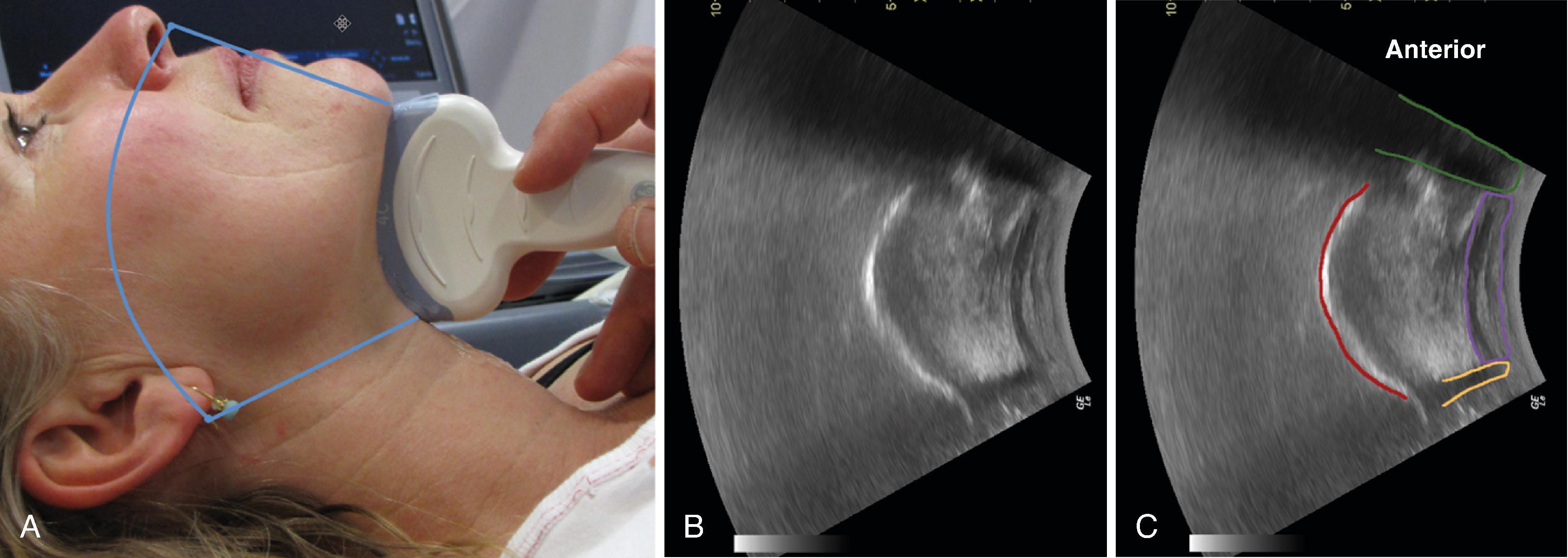
When the tongue is in contact with the palate, the palate can be visualized; if there is no contact with the palate, the air at the dorsum of the tongue will make visualization of the palate impossible. An improved image is achievable if water is ingested and retained in the oral cavity. The water eliminates the air-tissue border and allows visualization of most of the oral cavity including the palate ( Fig. 3.4 ), as well as a better differentiation of the hard palate from the soft palate.
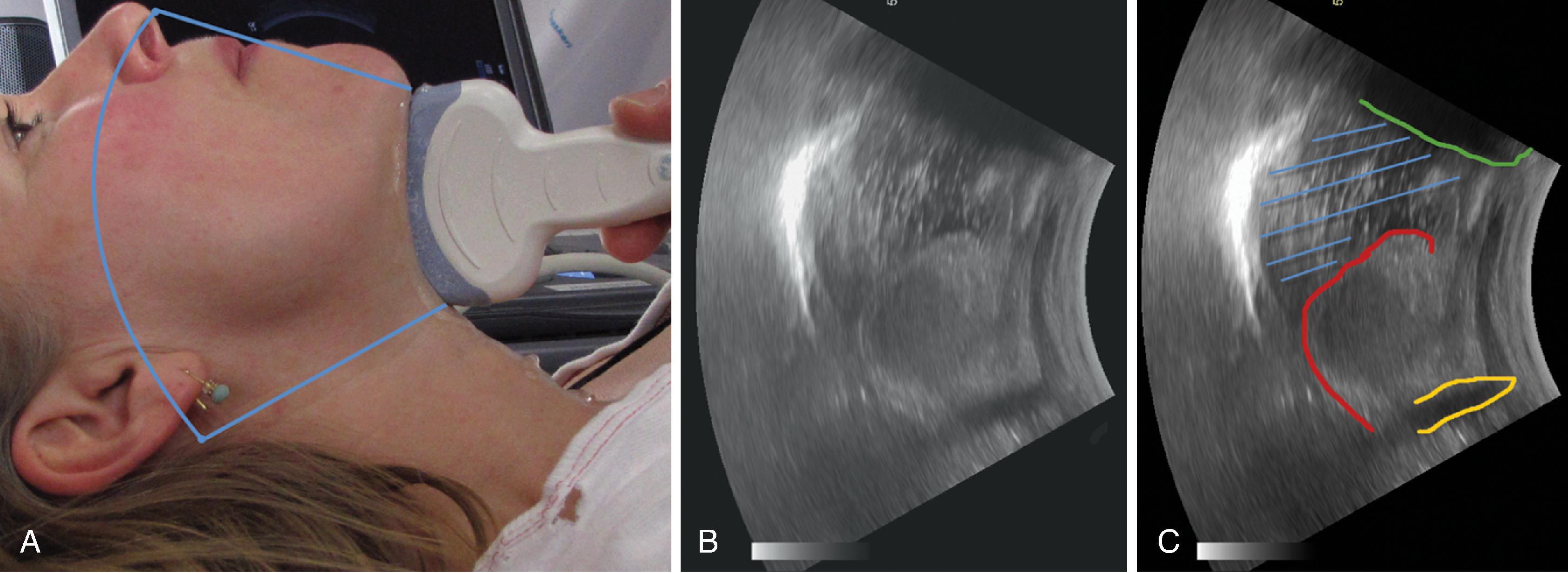
The tongue can be visualized in detail with the use of three-dimensional USG. In a child, the major anatomic components of the tongue and mouth are covered by four scanning positions: the midline sagittal, the parasagittal, the anterior coronal, and the posterior coronal planes. In the transverse midline plane just cranial to the hyoid bone, the tongue base and the floor of the mouth are seen. In the transverse (axial) plane in the midline, the lingual tonsils and the vallecula can be imaged. The vallecula is seen just below the hyoid bone, and when the probe is angled caudally, the preglottic and paraglottic spaces and the infrahyoid part of the epiglottis are seen.
Imaging of a part of the lateral border of the mid-oropharynx can be obtained by placing the transducer vertically with its upper edge approximately 1 cm below the external auditory canal. The lateral pharyngeal border and the thickness of the lateral parapharyngeal wall can be determined. The parapharyngeal space can also be visualized via the mouth by placing the probe directly over the mucosal lining of the lateral pharyngeal wall, but this approach is difficult for the patient to tolerate.
By performing USG through the thyrohyoid membrane, cricothyroid space, cricothyroid membrane (CTM), thyroidal cartilage lamina, and along the posterior edge of the thyroid lamina, it is possible to locate and classify hypopharyngeal tumors with a success rate as high as that achieved with computed tomography (CT) scanning.
The hyoid bone is a key landmark that separates the upper airway into two scanning areas: the suprahyoid and infrahyoid regions. The hyoid bone is visible on the transverse view as a superficial, hyperechoic, inverted U–shaped, linear structure with posterior acoustic shadowing. On the sagittal and parasagittal views, the hyoid bone is visible in cross-section (see Fig. 3.4 ) as a narrow, hyperechoic, curved structure that casts an acoustic shadow.
Because of the superficial location of the larynx, USG offers images of higher resolution than CT or magnetic resonance imaging (MRI) when a linear high-frequency transducer is used. The different parts of the laryngeal skeleton have different sonographic characteristics. The hyoid bone is calcified early in life, and its bony shadow is an important landmark. The thyroid and cricoid cartilages show variable but progressive calcification throughout life, whereas the epiglottis stays hypoechoic. The true vocal cords overlie muscle that is hypoechoic, whereas the false cords contain hyperechoic fat.
The thyrohyoid membrane runs between the caudal border of the hyoid bone and the cephalad border of the thyroid cartilage and provides a sonographic window through which the epiglottis can be visualized in all subjects when the linear transducer is oriented in the transverse plane (with varying degrees of cephalad or caudad angulation). The midline sagittal scan through the upper larynx from the hyoid bone cranially to the thyroid cartilage distally ( Fig. 3.5 ) reveals the thyrohyoid ligament, the preepiglottic space containing echogenic fat, and, posterior to that, a white line representing the laryngeal surface of the epiglottis. On parasagittal view, the epiglottis appears as a hypoechoic structure with a curvilinear shape; on transverse view, it is shaped like an inverted C. It is bordered anteriorly by the hyperechoic, triangular preepiglottic space and lined posteriorly by a hyperechoic air-mucosa interface. In a convenience sample of 100 subjects, a transverse midline scan cranially to the thyroid cartilage depicted the epiglottis in all subjects and revealed an average epiglottis thickness of 2.39 mm.
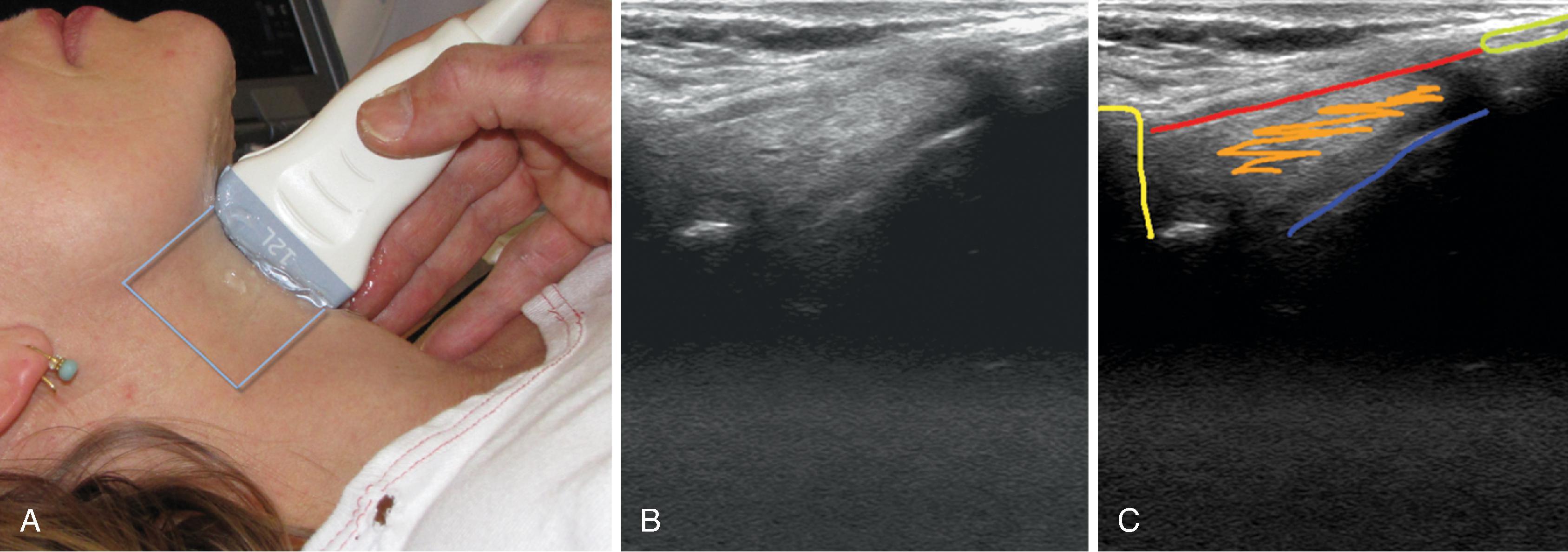
In the cricothyroid region, the probe can be angled cranially to assess the vocal cords and the arytenoid cartilages and, thereafter, moved distally to image the cricoid cartilages and the subglottis. With transverse scanning in the paramedian position, the following structures can be visualized (starting cranially and moving distally): faucial tonsils, lateral tongue base, lateral vallecula, strap muscles, laminae of the thyroid cartilage, the lateral cricoid cartilage, and, posteriorly, the piriform sinuses and the cervical esophagus.
The laryngeal cartilage is noncalcified in children, but calcification begins in some individuals before the age of 20 and increases with age. In subjects with noncalcified cartilage, the thyroid cartilage is visible on sagittal and parasagittal views as a linear, hypoechoic structure with a bright air-mucosa interface at its posterior surface. On the transverse view, it has an inverted V shape ( Fig. 3.6 ), within which the true and false vocal cords are visible. By 60 years of age, all individuals show signs of partial calcification, and approximately 40% of the cartilage at the level of the vocal cords is calcified. The calcification is seen as a strong echo with posterior acoustic shadowing. Often the anatomic structures can be visualized despite the calcifications by angling the transducer. In a population of patients who were examined due to suspicion of laryngeal pathology, sufficient visualization of the false cords was obtained in 60% of cases, of the vocal cords in 75%, of the anterior commissure in 64%, and of the arytenoid region in 71%; in 16% of cases, no endolaryngeal structures could be seen.

In individuals with noncalcified thyroid cartilages, the false and the true vocal cords can be visualized through the thyroid cartilage. In individuals with a calcified thyroid cartilage, the vocal cords and the arytenoid cartilages can still be seen by combining the scan obtained by placing the transducer just cranial to the superior thyroid notch while angling it caudally, with the scans obtained from the CTM in the midline and on each side with the transducer angled 30 degrees cranially.
The true vocal cords appear as two triangular, hypoechoic structures (the vocalis muscles) outlined medially by the hyperechoic vocal ligaments (see Fig. 3.6 ). They are observed to oscillate and move toward the midline during phonation. The false vocal cords lie parallel and cephalad to the true cords, are more hyperechoic in appearance, and remain relatively immobile during phonation.
In 24 volunteers with a mean age of 30 years, the thyroid cartilage provided the best window for imaging the vocal cords. In all participants, it was possible to visualize and distinguish the true and false vocal cords by moving the transducer in a cephalic-caudal direction over the thyroid cartilage. In a study of 229 participants ranging in age from 2 months to 81 years, the true and false cords were visible in all female participants; in males, the visibility was 100% for those younger than 18 years and gradually decreased to less than 40% in males 60 years of age and older.
The CTM runs between the caudal border of the thyroid cartilage and the cephalad border of the cricoid cartilage. It is clearly seen on sagittal ( Fig. 3.7 ) and parasagittal views as a hyperechoic band linking the hypoechoic thyroid and cricoid cartilages. The cricoid cartilage has a round, hypoechoic appearance on the parasagittal view; on the transverse view, it has an archlike, inverted C-shape appearance with a posterior white lining.

The location of the trachea in the midline of the neck makes it a useful reference point for transverse ultrasound imaging. The cricoid cartilage marks the superior limit of the trachea; it is thicker than the tracheal rings below and is seen as a hypoechoic, rounded structure. It serves as a reference point during performance of the sagittal midline scan (see Fig. 3.7 ). Often, the first six tracheal rings can be imaged when the neck is in mild extension. The trachea is covered by skin, subcutaneous fat, the strap muscles, and, at the level of the second or third tracheal ring, the isthmus of the thyroid gland (see Fig. 3.7 ). The strap muscles appear hypoechoic and are encased by thin hyperechoic lines from the cervical fascia. A high-riding innominate artery may be identified above the sternal notch as a transverse anechoic structure crossing the trachea. The tracheal rings are hypoechoic, and they resemble a “string of beads” or “string of pearls” in the parasagittal and sagittal plane (see Fig. 3.7 ). In the transverse view, they resemble an inverted U, or horseshoe, highlighted by a hyperechoic air-mucosa interface with reverberation artifact posteriorly ( Fig. 3.8 ).
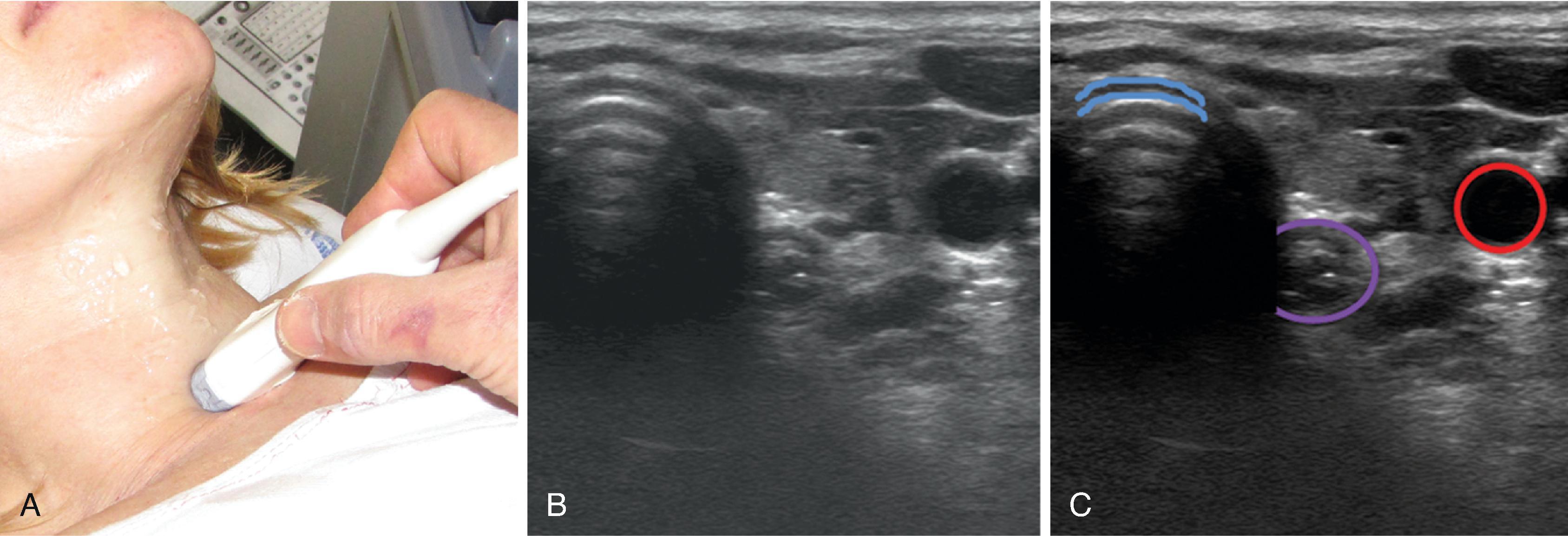
The cervical esophagus is most often visible posterolateral to the trachea on the patient’s left side at the level of the suprasternal notch (see Fig. 3.8 ). The concentric muscle layers of the esophagus result in a characteristic “bull’s-eye” appearance on USG. The esophagus can be seen to compress and expand with swallowing, and this feature can be used for accurate identification. The patient may be placed in a modified position for examining the esophagus by slightly flexing the neck with a pillow under the head and turning the head 45 degrees to the opposite side while the neck is scanned on either side; this technique makes the esophagus visible also on the right side in 98% of cases.
Become a Clinical Tree membership for Full access and enjoy Unlimited articles
If you are a member. Log in here